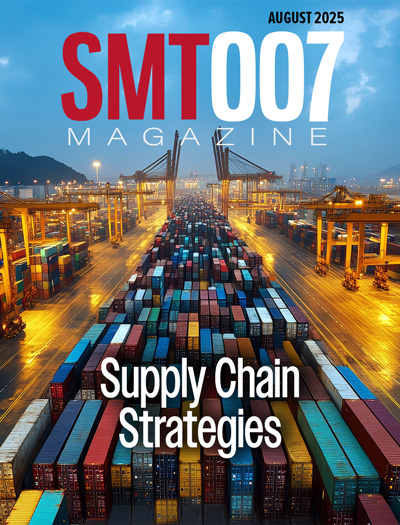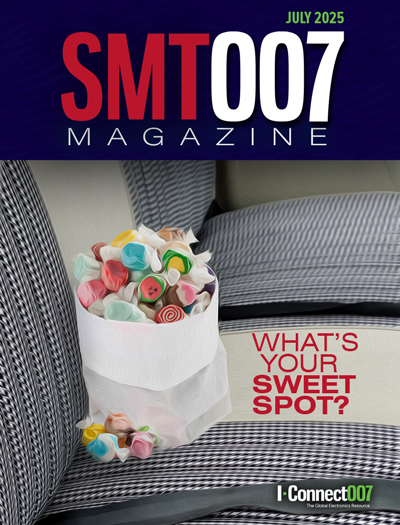-

- News
- Books
Featured Books
- smt007 Magazine
Latest Issues
Current Issue
Spotlight on India
We invite you on a virtual tour of India’s thriving ecosystem, guided by the Global Electronics Association’s India office staff, who share their insights into the region’s growth and opportunities.

Supply Chain Strategies
A successful brand is built on strong customer relationships—anchored by a well-orchestrated supply chain at its core. This month, we look at how managing your supply chain directly influences customer perception.

What's Your Sweet Spot?
Are you in a niche that’s growing or shrinking? Is it time to reassess and refocus? We spotlight companies thriving by redefining or reinforcing their niche. What are their insights?
- Articles
- Columns
- Links
- Media kit
||| MENU - smt007 Magazine
Mike Jouppi Discusses his Drive for Better Thermal Data
January 12, 2018 | Andy Shaughnessy, PCB Design007Estimated reading time: 7 minutes
If you mention thermal management in a group of PCB designers and design engineers, Mike Jouppi’s name usually pops up. Mike is an engineer and founder of the Thermal Management LLC consulting firm. He spent years updating IPC’s charts on current-carrying capacity, which had been unchanged since the 1950s. An advocate of a multi-physics approach to solving thermal issues, Mike is always on the cutting edge of electronics cooling. I recently caught up with Mike and asked him to give us his views on the state of thermal management, as well as the tools and standards related to thermal design.
Andy Shaughnessy: Mike, why don’t you give us some of your background, and explain how you got into thermal management.
Mike Jouppi: Sure. I'm a mechanical engineer and I've been doing thermal analysis since I got out of college. I started out working for Hughes Aircraft Company in 1982. I worked on missile systems for 14 years and then moved to Colorado and I've been working on spacecraft since then. Over that time, I've worked on electronics in missile systems as well as spacecraft and I've also done systems analysis for both of those product lines, from a system level to the electronics. So I’ve got a pretty good idea of where my boundary conditions come from and many of the problems that come with doing thermal analysis on electronics. I've done detailed thermal analysis on electronics parts and boards all the way down to looking at electrical conductors and conductor heating, which how I started to volunteer some of my time with IPC, which dates back to 1989.
In 1990, I became chairman of the IPC Task Group 1-10B, which manages a standard called IPC 2152, which is the Standard for Determining Current Carrying Capacity in Printed Board Design. Over the last several years, I've been working on getting volunteers to contribute to develop better information to work with conductor heating. What I've found is that the standards for managing conductor heating is somewhat archaic in that the industry really likes to use some nomographs, usually in the form of an online calculator. The nomograph is basically just a simple way of coming up with an estimate of temperature rise as a function of the amount of current supply to a trace or a track or whatever you want to call it. Those, in my opinion, are not adequate for solving more difficult problems such as current in vias, microvias, neckdowns, odd shaped geometries, etc. We don’t have test data to support anything but traces that were tested to create the charts in the standard.
The other problem is that people don't understand where the data comes from and how it can be more useful than they think. Many people fail to account for the fundamental rule for parallel conductors. So I've been working a lot on trying to get people educated on that whole area and that's been my focus as a volunteer through IPC.
Shaughnessy: Compared to issues like signal integrity, thermal management has only shown up relatively recently on the radar of most electrical engineers and PCB designers. I imagine today’s boards with high power or high current requirements are pushing the thermal envelope.
Jouppi: Thermal problems have been around for a long time. There has just been more margin in older design practices. That margin has allowed designers to get away with not applying the parallel conductor rule, which requires a strategy. In addition, when you've got high current, often, on the design side there are certain areas that people just don't have good solutions such as vias, microvias, neckdowns, wagon wheels, high current pulses, fusing current. I have a list of a dozen areas that need improvement. I would venture to guess that most people don't have the thermal management tools to adequately design their circuitry.
For example, when a design has high current in wagon wheels, neck-downs, odd-shaped geometries, etc., a lot of companies don't have the budget to have people specialized in heat transfer to solve these problems. Many companies only have a single discipline, like an electrical engineer, doing the design and also doing the thermal management and trying to come up with good solutions for these high current and/or high-power applications. There are a lot of cases where it just kind of drives problems. This is where people tend to over-design and issues flow to the manufacturing/assembly area, it’s just another area that needs to have more communication and focus.
That’s for all technologies where you've got high power or high current. I think a lot of thermal management can be automated, but there isn't much going on to automate it. There's still that human interaction. There's an IPC standard, I think it’s IPC-2581, where they're working on data flow and the process from design to PCB manufacturing. I would like to see something thrown in there for thermal management.
The other thing that I see is we don't always have very good thermal properties for the dielectric materials. Typically, it doesn’t matter for a thermal analysis of a circuit board. Although, the work that we've done with IPC-2152, it’s been critical to have the thermal conductivity in each axis as well as the density and the specific heat for the dielectric materials that we used to create our charts. So I would like to see better properties and tools.
Once we have good properties and the right thermal modeling tools, we will be able to manage all those hidden thermal problems much easier. The tools are getting better, but they have challenges to get where they need to be.
Shaughnessy: You’ve been involved with IPC for decades now. How are their standards coming along regarding thermal PCB issues?
Jouppi: I only see a little of what is going on through the 1-10b task group efforts. I see a lot of people volunteering their time, which is great, but I’m not sure what is being done toward PCB thermal management other than what we are doing with IPC-2152. Maybe I should get out more. The key to the standards is that if you want to get something done, you have to step up and do it. I ask people to consider adding the measurement of thermal conductivity in each axis, density and specific heat to dielectric material specifications, but I’m not willing to own it. I’ve done that for printed electronics too. When you start printing electronics, if you ever want to run any current through them, there's a whole current carrying issue to be worked. We need to know the electrical properties and the thermal properties of whatever you're printing and printing on.
Shaughnessy: Do you think the EDA tools are keeping up with thermal demands, Mike?
Jouppi: Well, they're getting there. It's a multi-physics problem when you start running current through conductors. You’ve got energy losses and calculating that power is a challenge. You know the one thing that really would simplify a lot is that in the Gerber data, or whatever people are using for driving their design through, if we could add current to each of the nets we would have all the information necessary to calculate what the power and power densities are. And then knowing the thermal properties locally throughout the board, you'd be a lot closer to being able to come up with temperature calculations for whatever environment you have.
The manufacturing/assembly line is an environment, the lab is an environment and the operational use of the product is an environment, and they're all different. Each of those different areas have different needs and requirements that are important for calculating temperatures and knowing the limits.
There are a few software tools for calculating conductor heating, but they all have their limits. It’s important for people to start using these tools and communicate with the software developers. Software companies work very hard to provide what customers want. It’s a two-way street.
Shaughnessy: Is there anything that you’d like to add, Mike?
Jouppi: I'm curious what the end-users out there are using for some of those really high-current applications, and it would be interesting to see what they use for thermal analysis software tools. It would be helpful to get some feedback from end-users as to what kind of problems they are running into on the thermal management side. Especially if it’s related to conductor heating.
Shaughnessy: This has been great. Thanks for speaking with me, Mike.
Jouppi: Thank you, Andy.
Testimonial
"Advertising in PCB007 Magazine has been a great way to showcase our bare board testers to the right audience. The I-Connect007 team makes the process smooth and professional. We’re proud to be featured in such a trusted publication."
Klaus Koziol - atgSuggested Items
Deca, Silicon Storage Technology Announce Strategic Collaboration to Enable NVM Chiplet Solutions
09/11/2025 | Microchip Technology Inc.As traditional monolithic chip designs grow in complexity and increase in cost, the interest and adoption of chiplet technology in the semiconductor industry also increases.
I-Connect007 Launches New Podcast Series on Ultra High Density Interconnect (UHDI)
09/10/2025 | I-Connect007I-Connect007 is excited to announce the debut of its latest podcast series, which shines a spotlight on one of the most important emerging innovations in electronics manufacturing: Ultra-High-Density Interconnect (UHDI). The series kicks off with Episode One, “Ultra HDI: What does it mean to people? Why would they want it?” Host Nolan Johnson is joined by guest expert John Johnson, Director of Quality and Advanced Technology at American Standard Circuits (ASC).
Global Citizenship: Together for a Perfect PCB Solution
09/10/2025 | Tom Yang -- Column: Global CitizenshipIf there’s one thing we’ve learned in the past few decades of electronics evolution, it’s that no region has a monopoly on excellence. Whether it’s materials science breakthroughs in Europe, manufacturing efficiencies in China, or design innovations in Silicon Valley, the PCB industry thrives on collaboration.
The Shaughnessy Report: Winning the Signal Integrity Battle
09/09/2025 | Andy Shaughnessy -- Column: The Shaughnessy ReportWhen I first started covering this industry in 1999, signal integrity was the hip new thing in PCB design. Conference classes on signal integrity were packed to the walls, and an SI article was guaranteed to get a lot of reads.
The Signal Integrity Issue: Design007 Magazine September 2025
09/09/2025 | I-Connect007 Editorial TeamAs the saying goes, “If you don’t have signal integrity problems now, you will eventually.” This month, our experts share a variety of design techniques that can help PCB designers and design engineers achieve signal integrity.


